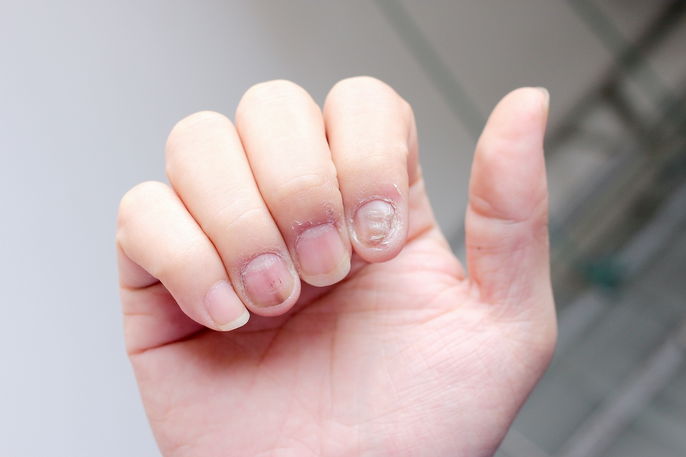What is it:
Nail psoriasis occurs when immune system cells attack the nails, causing symptoms like wavy, thick and brittle nails with white or brown spots.
Although there is no cure, you can improve nail appearance with treatment as prescribed by a dermatologist. Treatment may include using enamels and ointments with substances like clobetasol and vitamin D.
There are also home remedies that you can use, like keeping your nails clean and hydrated, and maintaining a diet that is rich in omega-3 foods like flaxseed, salmon and tuna.

Main symptoms
The main symptoms of nail psoriasis are:
- Wavy nails
- Deformed nails
- Brittle or scaling nails
- White or brown spots
- Increased nail thickness
- Nails falling off
- Bleeding
Nail psoriasis can affect one or several nails, and can present very similarly to a fungal nail infection. Therefore, if you notice any changes to your nails, you should see a dermatologist to determine the underlying cause and start treatment as appropriate.
Confirming a diagnosis
A nail psoriasis diagnosis is confirmed by a dermatologist through assessment of different nail characteristics. To rule out a fungal infection, the doctor may order a nail scrape or send a piece of the nail for analysis in the lab.
Treatment options
Treatment for nail psoriasis should be prescribed by a dermatologist. Treatment can vary based on the severity of symptoms, how many nails are affected, and the patient’s general health status.
Treatment may include:
1. Enamel
Nail psoriasis can leave the nails rough and soft, which is why using enamel can help with treatment while improving nail appearance. There are many enamels that contain products like vitamin D and clobetasol, which help to rebuild the nails. It is important to consult a doctor before applying any enamels to nails affected by psoriasis, as not all enamels may not be beneficial.
2. Ointments
In more mild cases of nail psoriasis, the doctor may prescribe ointments that contain vitamin D, vitamin D, corticosteroids and immunosuppressants. These ointments act by decreasing inflammation and helping to rebuild the nail. They should only be used as prescribed.
In some cases, when psoriasis affects the nails and other areas of the body (like the palms) these ointments can be used in combination with other types of medications.
3. Medications
When other areas of the body are affected, or if local treatment with enamel or ointments are not effective, the doctor can prescribe other medications, like methotrexate, cyclosporin, retinoids and corticosteroids. In general, these medications decrease immune system cell action in the body to relieve symptoms.
In more advances cases of nail psoriasis, the doctor may prescribe corticosteroid injections, which can be injected with local anesthesia. People with nail psoriasis taking medications should be monitored by a rheumatologist to ensure the duration and dosing remains appropriate.
4. Home remedies
Some remedies can be done at home to compliment medical treatment, like keeping your nails short and clean. To clean your nails, you should use a neutral, antibacterial soap. Avoid using hard sponges or thick brushes, as this can cause bleeding in already weakened nails.
You are recommended to use nail clippers instead of scissors to cut your nails, as scissors can increase the risk for injury. Also be sure to keep your nails hydrated with products recommended by your doctor, as this will help to prevent ingrown nails.
5. Diet
To manage nail psoriasis symptoms, you should avoid inflammatory foods like red meat, sausages, canned food, hotdogs, bacon, spicy food and food with artificial preservatives.
In addition, it is important to increase your consumption of fruits, vegetables and fruits that are rich in omega-3, like flaxseed, salmon, tuna, nuts and chestnuts.






























